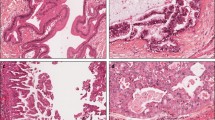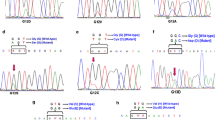Abstract
Background
Mutations of KRAS are known to occur in periampullary and ampullary adenomas and carcinomas. However, nothing is known about NRAS, HRAS, BRAF, and PIK3CA mutations in these tumors. While oncogenic BRAF contributes to the tumorigenesis of both pancreatic ductal adenocarcinoma and intraductal papillary mucinous neoplasms/carcinomas (IPMN/IPMC), PIK3CA mutations were only detected in IPMN/IPMC. This study aimed to elucidate possible roles of BRAF and PIK3CA in the development of ampullary and periampullary adenomas and carcinomas.
Methods
Mutations of BRAF, NRAS, HRAS, KRAS, and PIK3CA were evaluated in seven adenomas, seven adenomas with carcinoma in situ, and 21 adenocarcinomas of the periampullary duodenal region and the ampulla of Vater. Exons 1 of KRAS; 2 and 3 of NRAS and HRAS; 5, 11, and 15 of BRAF; and 9 and 20 of PIK3CA were examined by direct genomic sequencing.
Results
In total, we identified ten (28.6%) KRAS mutations in exon 1 (nine in codon 12 and one in codon 13), two missense mutations of BRAF (6%), one within exon 11 (G469A), and one V600E hot spot mutation in exon 15 of BRAF. BRAF mutations were present in two of five periampullary tumors. All mutations appear to be somatic since the same alterations were not detected in the corresponding normal tissues.
Conclusion
Our data provide evidence that oncogenic properties of KRAS and BRAF but not NRAS, HRAS, and PIK3CA contribute to the tumorigenesis of periampullary and ampullary tumors; BRAF mutations occur more frequently in periampullary than ampullary neoplasms.


Similar content being viewed by others
References
Sarmiento JM, Nagomey DM, Sarr MG, Farnell MB. Periampullary cancers: are there differences? Surg Clin North Am 2001;81:543–555. doi:10.1016/S0039-6109(05)70142-0.
Baczako K, Buchler M, Beger HG, Kirkpatrick CJ, Haferkamp O. Morphogenesis and possible precursor lesions of invasive carcinoma of the papilla of Vater: epithelial dysplasia and adenoma. Hum Pathol 1985;16:305–310. doi:10.1016/S0046-8177(85)80018-6.
Yeo CJ, Cameron JL, Sohn TA, Lillemoe KD, Pitt HA, Talamini MA, Hruban RH, Ord SE, Sauter PK, Coleman J, Zahurak ML, Grochow LB, Abrams RA. Six hundred fifty consecutive pancreaticoduodenectomies in the 1990s: pathology, complications, and outcomes. Ann Surg 1997;226:248–257. discussion 257–260. doi:10.1097/00000658-199709000-00004.
Howe JR, Klimstra DS, Moccia RD, Conlon KC, Brennan MF. Factors predictive of survival in ampullary carcinoma. Ann Surg 1998;228:87–94. doi:10.1097/00000658-199807000-00013.
Sohn TA, Yeo CJ, Cameron JL, Koniaris L, Kaushal S, Abrams RA, Sauter PK, Coleman J, Hruban RH, Lillemoe KD. Resected adenocarcinoma of the pancreas-616 patients: results, outcomes, and prognostic indicators. J Gastrointest Surg 2000;4:567–579. doi:10.1016/S1091-255X(00)80105-5.
Howe JR, Klimstra DS, Cordon-Cardo C, Paty PB, Park PY, Brennan MF. K-ras mutation in adenomas and carcinomas of the ampulla of Vater. Clin Cancer Res 1997;3:129–133.
Park SH, Kim YI, Park YH, Kim SW, Kim KW, Kim YT, Kim WH. Clinicopathologic correlation of p53 protein overexpression in adenoma and carcinoma of the ampulla of Vater. World J Surg 2000;24:54–59. doi:10.1007/s002689910011.
Yoshida S, Todoroki T, Ichikawa Y, Hanai S, Suzuki H, Hori M, Fukao K, Miwa M, Uchida K. Mutations of p16Ink4/CDKN2 and p15Ink4B/MTS2 genes in biliary tract cancers. Cancer Res 1995;55:2756–2760.
Hahn SA, Schutte M, Hoque AT, Moskaluk CA, da Costa LT, Rozenblum E, Weinstein CL, Fischer A, Yeo CJ, Hruban RH, Kern SE. DPC4, a candidate tumor suppressor gene at human chromosome 18q21.1. Science 1996;271:350–353. doi:10.1126/science.271.5247.350.
Hruban RH, Wilentz RE, Kern SE. Genetic progression in the pancreatic ducts. Am J Pathol 2000;156:1821–1825.
McCarthy DM, Hruban RH, Argani P, Howe JR, Conlon KC, Brennan MF, Zahurak M, Wilentz RE, Cameron JL, Yeo CJ, Kern SE, Klimstra DS. Role of the DPC4 tumor suppressor gene in adenocarcinoma of the ampulla of Vater: analysis of 140 cases. Mod Pathol 2003;16:272–278. doi:10.1097/01.MP.0000057246.03448.26.
Peyssonnaux C, Eychene A. The Raf/MEK/ERK pathway: new concepts of activation. Biol Cell 2001;93:53–62. doi:10.1016/S0248-4900(01)01125-X.
Dhillon AS, Meikle S, Peyssonnaux C, Grindlay J, Kaiser C, Steen H, Shaw PE, Mischak H, Eychene A, Kolch WA. Raf-1 mutant that dissociates MEK/extracellular signal-regulated kinase activation from malignant transformation and differentiation but not proliferation. Mol Cell Biol 2003;23:1983–1993. doi:10.1128/MCB.23.6.1983-1993.2003.
Aguirre-Ghiso JA, Estrada Y, Liu D, Ossowski L. ERK(MAPK) activity as a determinant of tumor growth and dormancy; regulation by p38(SAPK). Cancer Res 2003;63:1684–1695.
Garnett MJ, Marais R. Guilty as charged: B-RAF is a human oncogene. Cancer Cell 2004;6:313–319. doi:10.1016/j.ccr.2004.09.022.
Calhoun ES, Jones JB, Ashfaq R, Adsay V, Baker SJ, Valentine V, Hempen PM, Hilgers W, Yeo CJ, Hruban RH, Kern SE. BRAF and FBXW7 (CDC4, FBW7, AGO, SEL10) mutations in distinct subsets of pancreatic cancer: potential therapeutic targets. Am J Pathol 2003;163:1255–1260.
Ishimura N, Yamasawa K, Karim Rumi MA, Kadowaki Y, Ishihara S, Amano Y, Nio Y, Higami T, Kinoshita Y. BRAF and K-ras gene mutations in human pancreatic cancers. Cancer Lett 2003;199:169–173. doi:10.1016/S0304-3835(03)00384-7.
Qiu W, Schonleben F, Li X, Su GH. Disruption of transforming growth factor beta-Smad signaling pathway in head and neck squamous cell carcinoma as evidenced by mutations of SMAD2 and SMAD4. Cancer Lett 2007;245:163–170. doi:10.1016/j.canlet.2006.01.003.
Katso R, Okkenhaug K, Ahmadi K, White S, Timms J, Waterfield MD. Cellular function of phosphoinositide 3-kinases: implications for development, homeostasis, and cancer. Annu Rev Cell Dev Biol 2001;17:615–675. doi:10.1146/annurev.cellbio.17.1.615.
Domin J, Waterfield MD. Using structure to define the function of phosphoinositide 3-kinase family members. FEBS Lett 1997;410:91–95. doi:10.1016/S0014-5793(97)00617-0.
Vivanco I, Sawyers CL. The phosphatidylinositol 3-kinase AKT pathway in human cancer. Nat Rev Cancer 2002;2:489–501. doi:10.1038/nrc839.
Vanhaesebroeck B, Alessi DR. The PI3K-PDK1 connection: more than just a road to PKB. Biochem J 2000;346(Pt 3):561–576. doi:10.1042/0264-6021:3460561.
Samuels Y, Wang Z, Bardelli A, Silliman N, Ptak J, Szabo S, Yan H, Gazdar A, Powell SM, Riggins GJ, Willson JK, Markowitz S, Kinzler KW, Vogelstein B, Velculescu VE. High frequency of mutations of the PIK3CA gene in human cancers. Science 2004;304:554. doi:10.1126/science.1096502.
Lee JW, Soung YH, Kim SY, Lee HW, Park WS, Nam SW, Kim SH, Lee JY, Yoo NJ, Lee SH. PIK3CA gene is frequently mutated in breast carcinomas and hepatocellular carcinomas. Oncogene 2005;24:1477–1480. doi:10.1038/sj.onc.1208304.
Campbell IG, Russell SE, Choong DY, Montgomery KG, Ciavarella ML, Hooi CS, Cristiano BE, Pearson RB, Phillips WA. Mutation of the PIK3CA gene in ovarian and breast cancer. Cancer Res 2004;64:7678–7681. doi:10.1158/0008-5472.CAN-04-2933.
Broderick DK, Di C, Parrett TJ, Samuels YR, Cummins JM, McLendon RE, Fults DW, Velculescu VE, Bigner DD, Yan H. Mutations of PIK3CA in anaplastic oligodendrogliomas, high-grade astrocytomas, and medulloblastomas. Cancer Res 2004;64:5048–5050. doi:10.1158/0008-5472.CAN-04-1170.
Bachman KE, Argani P, Samuels Y, Silliman N, Ptak J, Szabo S, Konishi H, Karakas B, Blair BG, Lin C, Peters BA, Velculescu VE, Park BH. The PIK3CA gene is mutated with high frequency in human breast cancers. Cancer Biol Ther 2004;3:772–775.
Qiu W, Schonleben F, Li X, Ho DJ, Close LG, Manolidis S, Bennett BP, Su GH. PIK3CA mutations in head and neck squamous cell carcinoma. Clin Cancer Res 2006;12:1441–1446. doi:10.1158/1078-0432.CCR-05–2173.
Schonleben F, Qiu W, Ciau NT, Ho DJ, Li X, Allendorf JD, Remotti HE, Su GH. PIK3CA mutations in intraductal papillary mucinous neoplasm/carcinoma of the pancreas. Clin Cancer Res 2006;12:3851–3855. doi:10.1158/1078-0432.CCR-06-0292.
Gallmeier E, Calhoun ES, Kern SE. No mutations in PIK3CA identified in pancreatic carcinoma. NOGO 2004;8:2.
Davies H, Bignell GR, Cox C, Stephens P, Edkins S, Clegg S, Teague J, Woffendin H, Garnett MJ, Bottomley W, Davis N, Dicks E, Ewing R, Floyd Y, Gray K, Hall S, Hawes R, Hughes J, Kosmidou V, Menzies A, Mould C, Parker A, Stevens C, Watt S, Hooper S, Wilson R, Jayatilake H, Gusterson BA, Cooper C, Shipley J, Hargrave D, Pritchard-Jones K, Maitland N, Chenevix-Trench G, Riggins GJ, Bigner DD, Palmieri G, Cossu A, Flanagan A, Nicholson A, Ho JW, Leung SY, Yuen ST, Weber BL, Seigler HF, Darrow TL, Paterson H, Marais R, Marshall CJ, Wooster R, Stratton MR, Futreal PA. Mutations of the BRAF gene in human cancer. Nature 2002;417:949–954. doi:10.1038/nature00766.
Naoki K, Chen TH, Richards WG, Sugarbaker DJ, Meyerson M. Missense mutations of the BRAF gene in human lung adenocarcinoma. Cancer Res 2002;62:7001–7003.
Yuen ST, Davies H, Chan TL, Ho JW, Bignell GR, Cox C, Stephens P, Edkins S, Tsui WW, Chan AS, Futreal PA, Stratton MR, Wooster R, Leung SY. Similarity of the phenotypic patterns associated with BRAF and KRAS mutations in colorectal neoplasia. Cancer Res 2002;62:6451–6455.
Chung CH, Wilentz RE, Polak MM, Ramsoekh TB, Noorduyn LA, Gouma DJ, Huibregtse K, Offerhaus GJ, Slebos RJ. Clinical significance of K-ras oncogene activation in ampullary neoplasms. J Clin Pathol 1996;49:460–464. doi:10.1136/jcp.49.6.460.
Gallinger S, Vivona AA, Odze RD, Mitri A, O’Beirne CP, Berk TC, Bapat BV. Somatic APC and K-ras codon 12 mutations in periampullary adenomas and carcinomas from familial adenomatous polyposis patients. Oncogene 1995;10:1875–1878.
Hagemann C, Rapp UR. Isotype-specific functions of Raf kinases. Exp Cell Res 1999;253:34–46. doi:10.1006/excr.1999.4689.
Hakimi MA, Bochar DA, Chenoweth J, Lane WS, Mandel G, Shiekhattar R. A core-BRAF35 complex containing histone deacetylase mediates repression of neuronal-specific genes. Proc Natl Acad Sci U S A 2002;99:7420–7425. doi:10.1073/pnas.112008599.
Moskaluk CA, Hruban RH, Kern SE. p16 and K-ras mutations in the intraductal precursors of human pancreatic adenocarcinoma. Cancer Res 1997;57:2140–2143.
Rozenblum E, Schutte M, Goggins M, Hahn SA, Lu J, Panzer S, Zahurak M, Goodman SN, Hruban RH, Yeo CJ, Kern SE. Tumor-suppressive pathways in pancreatic carcinoma. Cancer Res 1997;57:1731–1734.
Brose MS, Volpe P, Feldman M, Kumar M, Rishi I, Gerrero R, Einhorn E, Herlyn M, Minna J, Nicholson A, Roth JA, Albelda SM, Davies H, Cox C, Brignell G, Stephens P, Futreal PA, Wooster R, Stratton MR, Weber BL. BRAF and RAS mutations in human lung cancer and melanoma. Cancer Res 2002;62:6997–7000.
Pollock PM, Harper UL, Hansen KS, Yudt LM, Stark M, Robbins CM, Moses TY, Hostetter G, Wagner U, Kakareka J, Salem G, Pohida T, Heenan P, Duray P, Kallioniemi O, Hayward NK, Trent JM, Meltzer PS. High frequency of BRAF mutations in nevi. Nat Genet 2003;33:19–20. doi:10.1038/ng1054.
Rajagopalan H, Bardelli A, Lengauer C, Kinzler KW, Vogelstein B, Velculescu VE. Tumorigenesis: RAF/RAS oncogenes and mismatch-repair status. Nature 2002;418:934. doi:10.1038/418934a.
Acknowledgement
We thank Mr. Benjamin Howard-Cooper for his contribution to this publication. This work was supported by the NCI R01CA109525, R21CA127701, and the Pilot Grant from Pancreatic Cancer Action Network.
Author information
Authors and Affiliations
Corresponding author
Rights and permissions
About this article
Cite this article
Schönleben, F., Qiu, W., Allendorf, J.D. et al. Molecular Analysis of PIK3CA, BRAF, and RAS Oncogenes in Periampullary and Ampullary Adenomas and Carcinomas. J Gastrointest Surg 13, 1510–1516 (2009). https://doi.org/10.1007/s11605-009-0917-4
Received:
Accepted:
Published:
Issue Date:
DOI: https://doi.org/10.1007/s11605-009-0917-4




